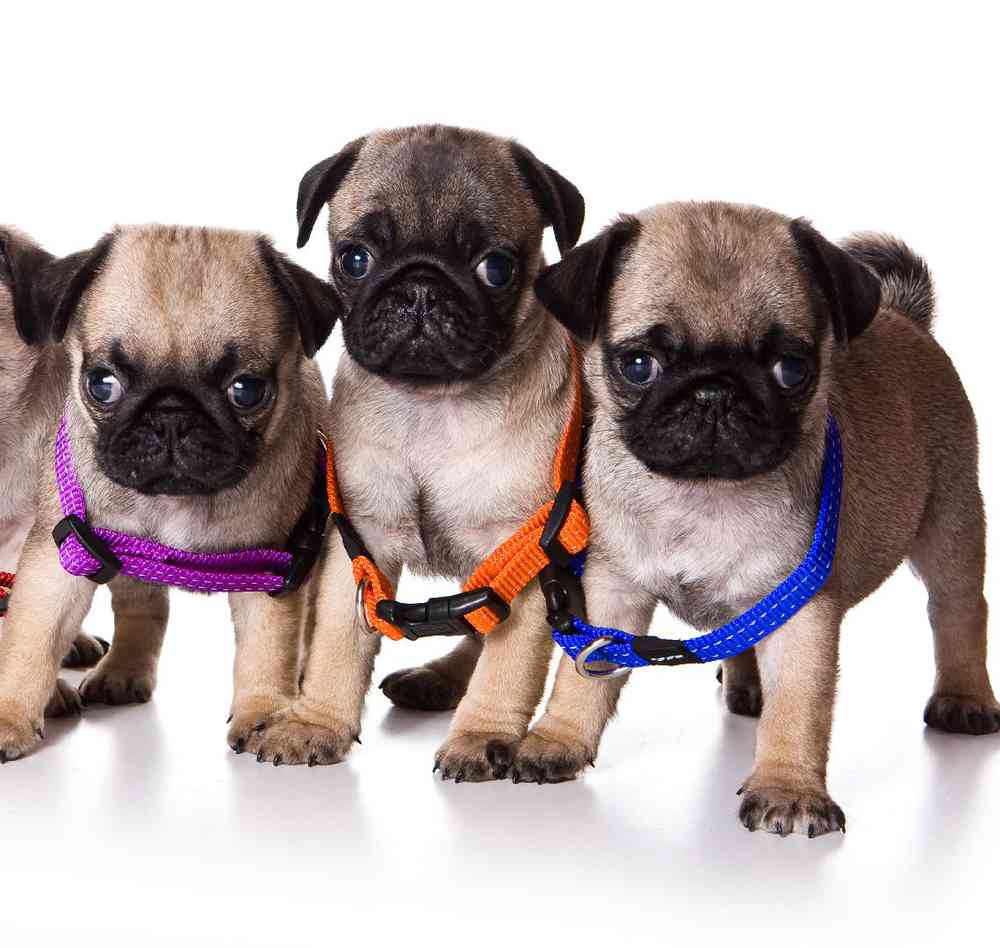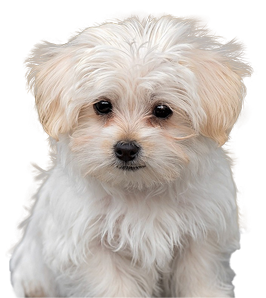
AKC Registrable
Apartment Friendly
Family Dog
Pug
Once the mischievous companion of Chinese emperors, and later the mascot of Holland’s royal House of Orange, the small but solid Pug is today adored by his millions of fans around the world. Pugs live to love and to be loved in return.
Available Pups
Puppy Knowledge
Breed Info
Clubs, Registries & Associations
American Canine Association Continental Kennel Club Universal Kennel Club International American Kennel Club United All Breed Registry America's Pet Registry, Inc. United Kennel Club (Based on breed recognition. See store for details on this particular puppy.)
Group
Toy
Heritage
The Pug originated in Asia before 400 BC, known first in Tibetan monasteries. The breed then appeared in Japan, then traveling to Eurpoe after the British seized the Chinese Imperial Palace and returning to England with several Pugs and Pekingese. Prince William II had several Pugs when he was the King of England. Today’s Pugs are popular as companion dogs and excel as watchdogs.
Description
Small, 10-14” at the shoulders, weighing anywhere from 12-20 pounds. The Pug has a solid and stocky body with a short and smooth coat that comes in colors of fawn, apricot, black, and silver. They have a curly-q tail and there are contests all over the country for the “curliest Pug tail” run by Pug enthusiasts.
Health Awareness
The Pug has a life expectancy of 12- 15 years and is prone to breathing issues due to brachycephalic muzzle, allergies, skin issues, eye problems and injury, epilepsy, patellar luxation and overeating. Overeating causes dangerous obesity issues.
Personality
They look like they’re carrying the weight of the world on their shoulders, but Pugs are fun, clownish, carefree, playful, busy, full of life and loving. They are highly intelligent, determined, yet emotionally sensitive. Use only humane motivational training with your Pug or you risk your Pug not responding to you. Your Pug will need you to be a confident, calm and humane leader giving consistent and achievable boundaries. Without your consistent and committed leadership, your Pug will likely develop stress issues and can become protective and guarding over food, toys, furniture, their areas and even you.
Exercise/Energy Level
Even though they are calm indoors, this is an active breed and will need daily exercise on a walk or play in a safe area. Be sure you provide plenty of mental stimulation or this breed can be destructive when bored.
Breed Standard
General Appearance
Symmetry and general appearance are decidedly square and cobby. A lean, leggy Pug and a dog with short legs and a long body are equally objectionable.
Size, Proportion, Substance
The Pug should be multum in parvo, and this condensation (if the word may be used) is shown by compactness of form, well knit proportions, and hardness of developed muscle. Weight from 14 to 18 pounds (dog or bitch) desirable. Proportion square.
Head
The head is large, massive, round–not apple-headed, with no indentation of the skull. The eyes are dark in color, very large, bold and prominent, globular in shape, soft and solicitous in expression, very lustrous, and, when excited, full of fire. The ears are thin, small, soft, like black velvet. There are two kinds–the "rose" and the "button." Preference is given to the latter. The wrinkles are large and deep. The muzzle is short, blunt, square, but not upfaced. Bite-A Pug's bite should be very slightly undershot.
Neck, Topline, Body
The neck is slightly arched. It is strong, thick, and with enough length to carry the head proudly. The short back is level from the withers to the high tail set. The body is short and cobby, wide in chest and well ribbed up. The tail is curled as tightly as possible over the hip. The double curl is perfection.
Forequarters
The legs are very strong, straight, of moderate length, and are set well under. The elbows should be directly under the withers when viewed from the side. The shoulders are moderately laid back. The pasterns are strong, neither steep nor down. The feet are neither so long as the foot of the hare, nor so round as that of the cat; well split-up toes, and the nails black. Dewclaws are generally removed.
Hindquarters
The strong, powerful hindquarters have moderate bend of stifle and short hocks perpendicular to the ground. The legs are parallel when viewed from behind. The hindquarters are in balance with the forequarters. The thighs and buttocks are full and muscular. Feet as in front.
Coat
The coat is fine, smooth, soft, short and glossy, neither hard nor woolly.
Color
The colors are fawn or black. The fawn color should be decided so as to make the contrast complete between the color and the trace and mask. Markings: The markings are clearly defined. The muzzle or mask, ears, moles on cheeks, thumb mark or diamond on forehead, and the back trace should be as black as possible. The mask should be black. The more intense and well defined it is, the better. The trace is a black line extending from the occiput to the tail.
Gait
Viewed from the front, the forelegs should be carried well forward, showing no weakness in the pasterns, the paws landing squarely with the central toes straight ahead. The rear action should be strong and free through hocks and stifles, with no twisting or turning in or out at the joints. The hind legs should follow in line with the front. There is a slight natural convergence of the limbs both fore and aft. A slight roll of the hindquarters typifies the gait which should be free, self-assured, and jaunty.
Temperament
Charming, Mischievous, Loving
Disqualifications
Any color other than fawn or black.
Overview
About
The Pug’s motto is the Latin phrase “multum in parvo” (a lot in a little)—an apt description of this small but muscular breed. They come in three colors: silver or apricot-fawn with a black face mask, or all black. The large round head, the big, sparkling eyes, and the wrinkled brow give Pugs a range of human-like expressions—surprise, happiness, curiosity—that have delighted owners for centuries. Pug owners say their breed is the ideal house dog. Pugs are happy in the city or country, with kids or old folks, as an only pet or in a pack. They enjoy their food, and care must be taken to keep them trim. They do best in moderate climates—not too hot, not too cold—but, with proper care, Pugs can be their adorable selves anywhere.
History
The Pug, often called the Pug Dog, is an ancient breed that can be traced back some 2,000 years. The emperors of ancient China had a preference for flat-faced toy dogs—the Pekingese, Shih Tzu, and Pug were all developed as refined pets of the emperor, his family, and members of the imperial court. Like many breeds favored by Far Eastern potentates of the ancient world, Pugs were a closely held treasure that outsiders could acquire only as a gift. The Pug’s career as citizen of the world began sometime in the 1500s, when Dutch traders returned to Europe with specimens of the breed. Legend holds that the Pug became the mascot of Holland’s royal House of Orange when a Pug save the life of the Prince of Orange by barking to warn the prince of an attack on his camp by Spanish troops. When William and Mary of Orange arrived in England to assume the monarchy, their Pugs accompanied them and began a craze for the breed among the British. The worldwide fascination with Pugs can be gauged by how many names the breed has had in various eras and places: Lo-sze (China), Mopsi (Finland), Doguillo (Spain) are just a few. Among the Dutch, still closely associated with Pugs, they are known as Mophonds. Theories abound as to the origin of the name Pug. One suggests that Pug is based on the Latin word “pugnus,” meaning “fist”—the idea being that the dog’s face resembles a clenched fist.
Standard
Symmetry and general appearance are decidedly square and cobby. A lean, leggy Pug and a dog with short legs and a long body are equally objectionable.
Nutrition
The Pug should do well on a high-quality dog food, whether commercially manufactured or home-prepared with your veterinarian’s supervision and approval. Any diet should be appropriate to the dog’s age (puppy, adult, or senior). Pugs live to eat and are prone to obesity, so watch your dog’s calorie consumption and weight level. , so watch your dog’s calorie consumption and weight level. Treats can be an important aid in training, but giving too many can cause obesity. Learn about which human foods are safe for dogs, and which are not. Check with your vet if you have any concerns about your dog’s weight or diet. Clean, fresh water should be available at all times.
Grooming
The Pug’s short, smooth, glossy coat needs minimal maintenance, but it does shed. Weekly brushing with a medium-bristle brush, a rubber grooming mitt, or a hound glove will help to remove the loose hair and help keep him looking his best. Pugs don’t need to be bathed unless they happen to get into something particularly messy or start to get a doggy odor. The Pug’s nails should be trimmed regularly, as overly long nails can cause him discomfort.
Exercise
Given the opportunity, a Pug will happily spend much of the day snuggling on the sofa—which, combined with the breed’s fondness for eating, makes obesity a real possibility. But the Pug is playful, sturdy, and lively, too, and owners can keep the breed fit with daily opportunities for moderate exercise, such as walks or play sessions in the yard. It’s vital to remember that as a short-faced breed Pugs aren’t tolerant of hot weather, and they shouldn’t do strenuous exercise when it’s warm or humid out—better to be in air-conditioning. Some canine sports in which Pugs participate and excel include agility, obedience, and rally.
Training
The Pug has been bred to be a companion and a pleasure to his owners. He has an even and stable temperament, great charm, and an outgoing, loving disposition. Pugs live to please their people, so they are generally easy to train. Their feelings are easily hurt, and harsh training methods should never be used. A Pug wants to be with his family and will be unhappy if he is regularly left alone for long periods of time. Early socialization and puppy training classes are recommended.
Health
The Pug’s dark, appealing eyes are one of his main attractions, but also one of his vulnerable spots. Eye problems including corneal ulcers and dry eye have been known to occur. Like all flat-faced breeds, Pugs sometimes experience breathing problems and do poorly in sunny, hot, or humid weather. The website of the breed’s parent club, the Pug Dog Club of America, offers detailed information on breed health.
Trivia
Interesting To Know
A favorite of film and television, Pugs have appeared in Men In Black as Frank the Pug, Hotel For Dogs, The Adventures Of Milo And Otis, Pocahontas, and The West Wing. Napoleon Bonaparte's wife, Josephine, had a Pug named "Fortune". This little Pug delivered secret messages under his collar to Napoleon when Josephine was imprisoned.




